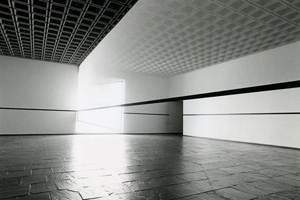Who Pays for Museums?
John Haberin New York City
Museum Expansions and Admissions to the Met
The Met has it all—great art, astounding exhibitions, and record attendance. Where museum expansions elsewhere have produced nasty real-estate deals and dubious architecture, the Cloisters, the Met Breuer, and its beloved home on Fifth Avenue have never looked better. Why then is it raising admission for so many?
The answer lies in its success. Growth comes at a cost, most especially the cost of the Met Breuer. Ben Davis raises sharp questions about growth in a critique of museum expansions and the direction of museums everywhere. And the questions return with still greater vigor as MoMA, the New Museum, and the International Center of Photography all undertake new buildings— and, with that, their second major expansion in recent memory. A few months later, the Met's admissions prices drive the questions home. 
The museum listicle
Does the Met need the Met Breuer? Does New York's largest museum need a third home on the scale of a major museum itself? Is it coincidence that the Met announced serious financial losses and further layoffs? A headline in one popular webzine promised to name the year's six best new museum buildings. Granted that webzines love listicles, but think about it—six best? Could there be that many more new museum buildings in a single year, so many that still others are losers?
Has growth grown out of control? The same question looms over soaring auction prices and gallery districts. Success may empower a handful of artists and dealers at the cost of decent art, while failure drives many more out of business. It happened after Hurricane Sandy, and it is already happening on the Lower East Side, even before Covid-19. No wonder some boast of "virtual exhibitions" and question the very need for brick-and-mortar galleries. A growing audience for art sure sounds positive, but could museums be making the mess worse?
It may seem churlish to ask. The Met has done well by the Met Breuer, restoring a landmark building and opening with a blockbuster, "Unfinished," soon followed by insightful looks at early Diane Arbus, Marsden Hartley, photography in India, and more. I, for one, breathed a sigh of relief that the former Whitney Museum, after the Whitney's move to the Meatpacking District, would not lie empty. Other museums could stand to learn something, with their architectural follies, empty atriums, and private collections as glorified tax shelters—not to mention MoMA's real estate empire, its 2019 expansion, and the sorry tale of LA MOCA under Jeffrey Deitch, the celebrity dealer. And yet the questions will not go away. They appear again in an essay by Ben Davis in The New York Times, and the Met dare not so much as mention the Met Breuer in its anniversary celebration of "Making the Met" in 2020.
Most new museum buildings and renovations address real needs, even before museums after Covid-19 and social distancing, even as costs mount and attendance is slipping nationwide. The Whitney wanted at least a floor for its permanent collection, the Morgan Library sought to connect its existing buildings, the New Museum, the Museum of American Folk Art, the International Center of Photography found themselves homeless, and Berkeley's art museum proved structurally unsound. The Met has articulated its needs, too, including displays of modern and contemporary art that its Lila Acheson Wallace wing could never hold—and the need to shut that wing entirely for renovation. Davis, though, sees another factor entirely. Collectors want to acquire and to exhibit recent art, and museums want them as donors. That puts pressure on a museum to welcome them to its board, to build, and to show off.
Davis is onto something. Even the Morgan Library and the Frick Collection have now stumbled onto living artists, and even the Asia Society will have its triennial. Still, he may not have all the answers. When the pursuit of profits leads to losses, and the pursuit of art becomes the pursuit of attention, something does not add up. Boards can demand only so much, and museums do not have to listen. The Met needs an endowment, but it also has a museum to manage, even as it adds sculpture to the Met's exterior.
I hesitate to blame the former director, Thomas P. Campbell, who inherited his share of other architectural follies, such as the Lehman wing and the modern wing itself, completed in 1987. Under his leadership, displays grew more adventurous and less self-serving, including "focus exhibitions" of selections from the permanent collection. Could the Met have stayed put, perhaps renovating its modern wing in pieces while mounting temporary displays elsewhere in its vast halls? It managed a new American wing and a superb new Islamic wing just by shutting the old ones for a while. Maybe one should ask not whether the Met needs the Met Breuer or must instead abandon it to the Frick Madison, but rather whether the rest of us do—and not just now, but for a sustainable future. When the Met's lease runs out after eight years, I should hate to remember it as just one more item in a listicle.
What you will
For all its signs of success, the Met is losing friends and losing money. It has cut staff, fired its last director, and delayed renovation of its twentieth-century wing. And now it will do the unthinkable: "pay what you will" may not apply to you. Those who care about the arts are not happy. They are also pointing fingers—often as not at that former director.
 For anyone from New York State, "suggested admissions" will still be just that, a suggestion. (Why the entire state, when the Met gets so much of its public funding from the city? Politics and tax deductions are a messy business.) So will students in and around the city. The museum promises not to turn away New Yorkers without an ID, for now, and kids under twelve will still get in free. Anyone else, though, must pay in full.
For anyone from New York State, "suggested admissions" will still be just that, a suggestion. (Why the entire state, when the Met gets so much of its public funding from the city? Politics and tax deductions are a messy business.) So will students in and around the city. The museum promises not to turn away New Yorkers without an ID, for now, and kids under twelve will still get in free. Anyone else, though, must pay in full.
How did the museum mess up its finances despite soaring revenues? As much as anything, it took on too much when it rented and renovated the Whitney's former home on Madison Avenue. It also accepted a huge gift from a trustee and right-wing political funder, David Koch, only to spend it on LED lights and pointless changes to its outdoor fountains. One can make a good case for the Met Breuer as a short-term investment in the display of recent art and the saving of a New York landmark, and gifts often come with strings attached. Then, too, for all Campbell's strengths as a curator and weakness as a financial manager, the board almost surely chose in favor contemporary art and eye candy, much as Davis says. Maybe Philippe de Montebello, his fabled predecessor, could have stood up to the board, but he also did more than anyone to commercialize the Met—and, with the Lehman wing and European sculpture court, to undertake its most tasteless expansion.
All is not lost, though, and one of the most convincing objections also helps explain why. The problem with high ticket prices is not just whom they exclude. It is also that they discourage museum-going as a way of life, as regular as catching or streaming a movie. It takes long acquaintance (or a good critic) to make art meaningful, not "just looking," and that can make an adult's life more meaningful as well. The Met is on the right track, then, in welcoming locals and students, and it will make commissions for its Great Hall free to the public, starting with paintings by Kent Monkman. More fully private museums charge at least as much.
Money has to come from somewhere, although less than a sixth comes from admissions, and people on vacation expect to spend money. That has drawbacks, if it makes New York a destination for the rich alone—and if art becomes as touristy as Broadway. Still, a museum can resist the demand for crowd pleasers, and the toxic mix of art and money is not going away any time soon. As an alternative to mandatory prices, some suggest a surcharge for special exhibitions. That would only encourage blockbusters, and exhibitions should be a way of life, too. They attract newcomers to art, make figures like Michelangelo more than a cliché, and introduce lesser artists and aspects of the permanent collection at that.
Still, something has gone terribly wrong, where even the Philadelphia Museum of Art feels the pressure, and there has to be another way to ask who pays. For starters, extend "pay what you will" to everyone in the New York area and to artists everywhere—or at the very least to everyone who commutes to work in the city. Second, other museums should not be off the hook. They could start their free evening (currently Fridays after seven at the Morgan Library or the Whitney) sooner or, better still, make an afternoon each week as cheap for locals as the Met. That might hinge on federal and state arts funding, but it should be part of the solution, too. Last, critics can stop fawning and insist that museums tempted by growth stick to their mission.

Ben Davis wrote in The Times for July 24, 2016, and Campbell announced on February 28, 2017, that he would be stepping down. The Met changed policy takes effect March 1, 2018.




